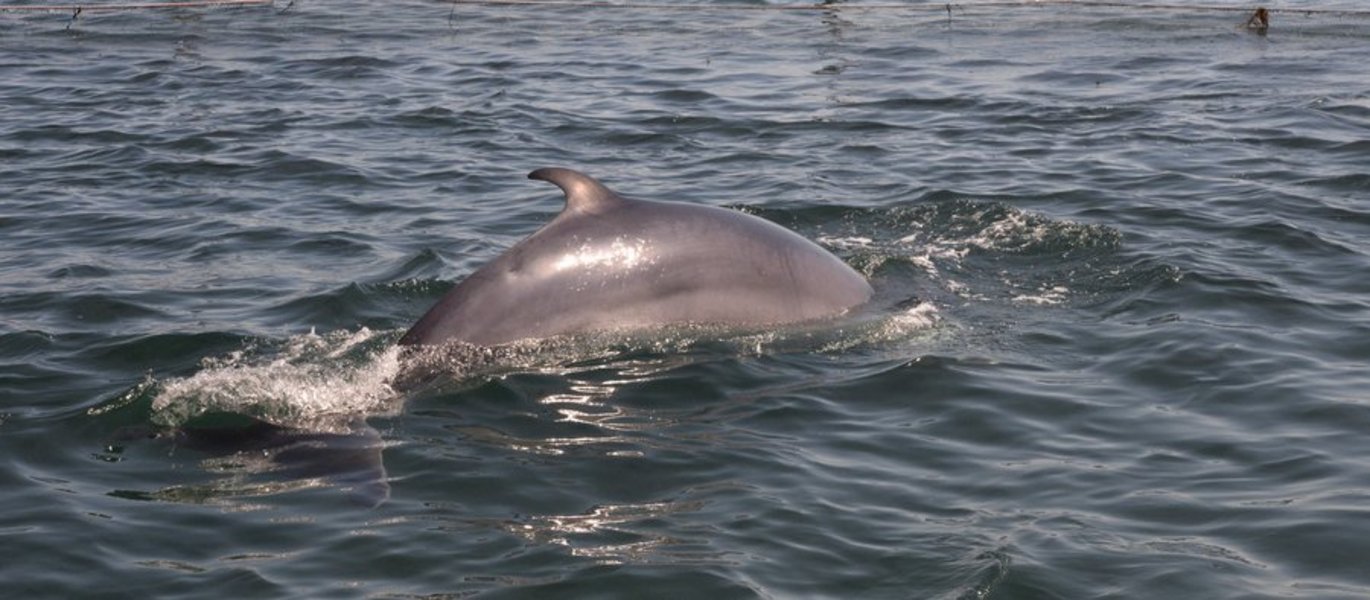Follow the journey of a minke whale
For the first time in 15 years, scientists have succeeded in tagging a minke whale. Follow it live.

(By Jonas Teilmann, Signe Sveegaard, Jeppe Dalgaard, Balle Line Kyhn and Rune Dietz)
On Friday 30 June, a minke whale swam into the pond net of Troels Tvilling of Skagen.
Right after he had seen the whale, he called for whale researchers at Aarhus University, who immediately began obtaining permission from the Danish Environmental Protection Agency to tag the whale and make the equipment ready for the tagging operation. Section for Marine Mammal Research at Aarhus University has since 1997 tagged about 150 harbour porpoises from pond nets and a large number of other marine mammals in Danish and Greenlandic waters with different types of electronic devices that inform us about their migrations and life below the surface.

Minke whale in fishing net before the tagging July 1. 2017. Photo: Line A. Kyhn
As the wind was 12-14 m/s from northeast, the tagging was postponed. Saturday at 13:07, fishermen and researchers went to the pond net and found the whale swimming around slowly. The net is just 15 minutes from the harbor near the south pier. Carefully, the boat moves into the pond net, which consists of a long net from land that guides fish into a giant net sack and now also a big whale. Another boat with, television, colleagues and family as well as a few curious fishing boats were also present. High above the pound net, Aarhus University's new drone is filming the entire operation from above, while the whale slowly swims around and breathes regularly. The fishermen starts pulling in the net over the railing of the fishing boat, which is about the size of the whale. As the whale gradually is caught between the boat and the net, the scientists begins to measure the animal. The whale measures 4.6 m, which corresponds to 4-5 years and a weight of approx. 1700 kg.
Minke whales can grow up to 10 meters in length and weigh up to 10 tons. The females are the largest and give on average a calf every second year, being weened by the female over the first year after birth.

Two researchers crawl out into the fishing net to attach the instruments to the whale's dorsal fin. Photo: AU.
Two of the researchers crawl out into the net and up on the whale to deploy the tags on the dorsal fin. The whale is located quite deep in the water, so the drill must work partially under the water. Three small 5 mm holes are drilled through the 25 cm high and 3 cm thick dorsal fin. Taking into consideration that the whale weighs 20-30 times more than a person, the tag corresponds to a piercing to a human. On one side of the fin, a satellite tag is attached with three silicone-coated nylon rods. On the opposite side, a GPS and dive logger is attached to one of the nylon rods with a magnesium nut. Magnesium corrodes in seawater after 14 days when the logger's memory is full, and loosens from the whale for later retrieval by the researchers. The satellite transmitter will fall off when the nuts rust away after a year's time and the battery is out of power.
After a quarter of dramatic work with garfish and mackerel jumping around their heads, the researchers are ready to let go of the whales. This is, however, going wrong as the whale whales swim into a corner of the net and get a loop of robe around the tail, which must be cut off before the whale can finally gain freedom and swim out of the net. With spontaneous clapping and yelling, fishermen and researchers wishes the whales, farewell! Everyone looks forward to see which route the whale will go over the coming months.
Only once before has a minke whale been tagged in Denmark. It was 15 years ago on June 5, 2003, where a 5m long minke whale was caught in the same pound net and tagged by the same researchers. This whale provided positions for 87 days, where it traveled 11,500 km, corresponding to 133 km per day. During this trip, the whale from Skagen crossed the North Sea to the British coast, after which it swam north and rounded Scotland. Then the trip went south along the westcoast of Ireland, east of the Azores and only when the whales came to Cape Verde, it turned around and reached the Canary Islands before going through the Strait of Gibraltar. When the whale approached Mallorca, the transmitter ceased transmitting as the battery ran out of energy.
It is now exciting to see whether the new minke whale will swim the same route or if it will follow new trails not previously seen. Hopefully, the new whaletag will provide an even longer and deeper insight into these giants' exploration of the Atlantic Ocean.
Follow the whale that automatically updates online:(Some positions may be on land due to uncertainty in the determination of the whale's position when it surfaces for a very short amount of time):
Check out more of AU's marine mammal research on Facebook.
For further information please contact professor Rune Dietz, Institut for Bioscience, at rdi@bios.au.dk or via phone at: 87158690
